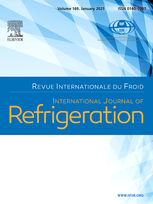
Summary
As one of the potential new generation refrigerants, R161 possesses the suitable thermodynamic properties and small climate change effects, but it is flammable. This paper contributed to its fundamental flammable characteristics theoretically and experimentally. Firstly, its flames were researched under various testing conditions. Then influences of temperature and vessel dimensions on the flammability limits of R161 were tested and analyzed. The results indicated that the lower flammability limits of R161 increased with the decrease of temperature while its upper flammability limits reduced oppositely, when initial temperature varied from 55°C to -5°C. Thirdly, a method was proposed to estimate the refrigerants' flammability limits, which concerned three impact parameters, the gas concentration, bond dissociation energies and enthalpy variations. Finally, the flame suppression effects of 1,1,1,2,3,3,3-heptafluoropropane (R227ea), trifluoroiodomethane (R13I1), and trans-1,3,3,3-tetrafluoropropene (R1234ze) to R161 were tested, and the critical flammability ratios (CFR) of some inhibitors to R161 were obtained
Available documents
Format PDF
Pages: 235-245
Available
Public price
20 €
Member price*
Free
* Best rate depending on membership category (see the detailed benefits of individual and corporate memberships).
Details
- Original title: Research on the flammable characteristics of fluoroethane (R161) and its binary blends.
- Record ID : 30014842
- Languages: English
- Source: International Journal of Refrigeration - Revue Internationale du Froid - vol. 56
- Publication date: 2015/08
Links
See other articles in this issue (21)
See the source
Indexing
-
Themes:
HFCs;
Blends - Keywords: R161; Temperature; Binary mixture; Flammability; Testing; Refrigerant
-
Phase equilibrium in mixtures of ammonia with n...
- Author(s) : ARTEMENKO S. V.
- Date : 2008
- Languages : Russian
- Source: Holodil'na Tehnika i Tehnologiâ - n. 5
View record
-
Performance d'un fluide quasi-azéotrope à faibl...
- Author(s) : COLBOURNE D., COX N., SUEN K. O., et al.
- Date : 2009/04
- Languages : French
- Source: Rev. gén. Froid - vol. 99 - n. 1092
View record
-
Thermodynamic analysis of the refrigeration cyc...
- Author(s) : ARTEMENKO S. V., POLÂK A. S.
- Date : 2012
- Languages : Ukrainian
- Source: Holodil'na Tehnika i Tehnologiâ - n. 6
View record
-
Evaluation of flammability characteristics of m...
- Author(s) : ZHANG Z., HE G., NING Q., WANG Z., YANG W., HUA J., ZHOU S.
- Date : 2023/12
- Languages : English
- Source: International Journal of Refrigeration - Revue Internationale du Froid - Vol. 156
- Formats : PDF
View record
-
Surface tension prediction for refrigerant bina...
- Author(s) : DI NICOLA G., PIERANTOZZI M.
- Date : 2013/03
- Languages : English
- Source: International Journal of Refrigeration - Revue Internationale du Froid - vol. 36 - n. 2
- Formats : PDF
View record
